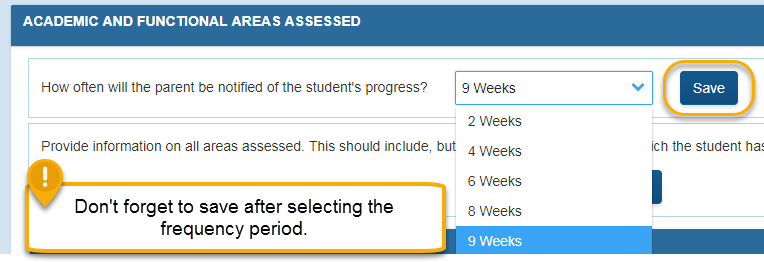Progress Frequency
Determine the frequency that parents will be notified of progress. This period of time may be standard in your school, or you may choose a more frequent period if needed for a particular student. You can choose from 2, 3, 4, 6, 8, or 9 weeks. This frequency period will apply to all goals in the IEP, including those goals developed as part of the transition plan. Progress on IEP goals should be reported at least as often as report cards are sent to parents.
Regular Progress monitoring of goals is a critical responsibility. It should target the specific goal and guide future instruction. This is particularly important for 12th grade students because all information in this section will be automatically included in the Summary of Performance.

Norm referenced, standardized tests such as the Woodcock Johnson III (WJIII), Wechsler Individual Achievement Test II (WIAT II), Key Math, Woodcock Reading Master Test (WRMT), etc. are not appropriate instruments to use when measuring progress toward IEP goals. These tests are broad, global instruments that were developed to measure a student’s skills at a specific point in time, i.e. for eligibility or diagnostic purposes. They were never designed, nor intended, to be used to measure progress from year to year or reporting period to reporting period. These instruments are not sensitive to the small incremental changes that occur during the school year. In addition, these tests measure many skills that are likely not part of the IEP goals…so the student is tested on information that hasn’t been taught.
Curriculum Based Measurement (CBM), on the other hand, measures what is being taught. CBMs are one to five- minute probes that provide direct, repeated assessment of each IEP goal. For example, a fifth grade student with reading comprehension skills at a third grade instructional level has a goal related to improving literal reading comprehension skills in fourth grade text. The CBM is developed using the same instructional level materials (fourth grade) and includes only literal [who, what, when, where] comprehension skills. By comparison, a measure such the WJ III that may only have one or two items at fourth grade level and measures both literal and inferential comprehension. In a situation such as this, the student is taking a test that is not on his/her instructional level and is being tested on inferential comprehension questions for which he/she has had no instruction.
There is a wealth of information regarding curriculum-based measurement. The Curriculum Based Assessment Warehouse and Intervention Central are examples. These resources are free of charge.